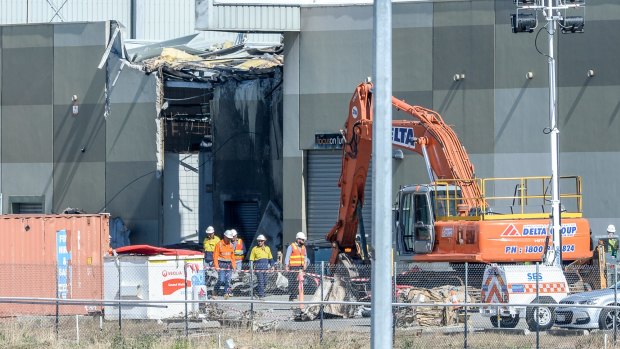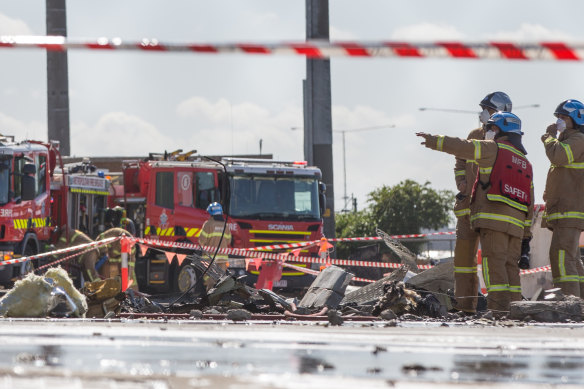
Save articles for later
Add articles to your saved list and come back to them any time.
An investigation triggered by the fatal DFO crash six years ago has found the private operator of the neighbouring Essendon Airport largely ignored modern safety standards about how close the shopping centre could be built to the runway.
But uncertainty around rules from the 1970s on how close buildings can be to runways, and an updated version of the code, meant the Australian Transport Safety Bureau (ATSB) could not find that the Direct Factory Outlet shopping centre should not have been built where it is, and it does not say it is unsafe.
Workers at the scene in 2017 of the plane crash at the DFO shopping centre in Essendon.Credit: Justin McManus
The bureau’s report also details the airport’s push to open up as much space for property development as possible by applying the outdated standards, which some pilots say is emblematic of how commercial buildings are encroaching on safe aviation operations at airports nationwide.
The safety regulator launched an investigation in 2017 into how the DFO building off Bulla Road was approved after a Beechcraft King Air crashed into the building’s side on February 21 that year, killing pilot Max Quartermain and his four passengers. In 2018, the ATSB found pilot error was to blame for the crash.
While investigating the crash, the ATSB discovered the DFO was within 150 metres of the southern runway, in an apparent breach of safety standards in place since 1987, which mandated a 300-metre “strip width” on such a runway, or a 150-metre buffer zone on each side.
The safety authority found the location of the DFO did not contribute to the crash, which happened on the building’s southern end. But the bureau was sufficiently concerned to launch a separate investigation into how the building was approved and built in 2005.
The DFO was one of the first buildings constructed around the airfield after the airport property was leased from the Commonwealth in 2001 for $22 million for a 99-year tenancy.
By 2016, Essendon Fields Airport management said the entire operation was worth $1 billion, having developed a hotel, car dealerships, retail outlets and other commercial buildings. Two small airlines, charter operators and emergency services still use the airport.
Essendon Airport reduced its strip width from 300 metres to 180 metres in 1971 when international flights moved to the new Melbourne Airport at Tullamarine, and that information was given to pilots to inform safety and operational decisions.
The ATSB’s final report into how the DFO was approved was published on June 30 – almost six years after launching the investigation – and it found that it was “unlikely” the airport “adequately determined” it was still able to use the 1970s standard when it submitted its plans to the federal government for the new DFO retail precinct in 2004.
Although rules for using “grandfathering” provisions – where the airport could continue to apply the 1970s standards – were “open to different interpretations”, the ATSB said it could find no evidence the Civil Aviation Safety Authority (CASA) had given the airport a concession to use that 180-metre clearance zone.
The bureau’s report says that in 2003, the airport’s management and CASA were discussing compliance with the modern rules, which made it “very unlikely the [older standards] had been identified at the time as the applicable standards”.
Captain Marcus Diamond, a safety and technical manager at the Australian Federation of Air Pilots, said the ATSB report largely agreed with the federation’s concerns that the airport ignored regulations intended to protect aviation activity and safety.
“The DFO should not have been built within the 300-metre strip width, which was the standard at the time and still is,” Diamond said.
Firefighters at the scene of the 2017 crash.Credit: Jason South
He said pilots were increasingly concerned about overdevelopment at airports around the country. Airports are leased out on the condition that tenants prioritise aviation operations.
“We’ll be calling for the government to put stricter processes in place … so we’re assured of protection of the aerodrome operations and that they’re not impinged by inappropriate buildings,” Diamond said.
The ATSB investigation details a 2003 email it uncovered, in which an Essendon Airport management officer advised that CASA had agreed verbally to the airport applying a strip width of 180 metres rather than 300 metres.
“This should open up about 36,000 square metres of new land for development,” the email says.
Pilot Max Quartermain (left) and passengers Russell Munsch, Glenn Garland and Greg De Haven were killed in the crash.
Essendon Airport relied heavily on a letter from a CASA officer confirming that interpretation a month later, but CASA told the ATSB investigation that advice was wrong and had no legal validity.
A CASA internal briefing from around the time the federal minister was approving the development plan said it would be difficult to justify reducing the strip width “especially for economic development reasons”.
Essendon Fields Airport declined to comment.
ATSB chief commissioner Angus Mitchell said the safety authority’s investigation did not find that the DFO was unsafe or should not have been built, but the bureau could not confirm how the airport determined the development was compliant with the rules.
“We can’t say it was in breach, or it was in accordance, because of that uncertainty of what standard applied and what was being used at the time,” Mitchell said.
The final report only identified one safety issue, which is that the federal Department of Transport did not have an agreed assurance framework with CASA for assessing airport development plans.
CASA made findings in 2012 and 2014 that the 180-metre Essendon runway strip was not compliant. In 2015, CASA ordered the airport to notify airport users that the runway had a 300-metre strip while identifying “approved obstacles” including the DFO within that area.
In 2019, the airport used “grandfathering” provisions to revert the runway back to a 180-metre strip, which CASA accepted, meaning the DFO was no longer identified as an obstacle.
However, the ATSB found the airport and CASA “did not consider all the relevant risk information” when making that decision and “greater safety assurance could have been provided”.
Diamond said the reduced length of the runway had downgraded Essendon’s status as an airport because some operators chose not to use the lower category of runway with bigger aircraft.
The ATSB’s investigation is one of the longest it has undertaken, with three draft reports prompting extensive challenges from the airport and CASA.
A CASA spokesperson said the agency “remains satisfied” the DFO did not breach the runway clearance area, and “that the development was safe and compliant when it was approved and remains safe and compliant”.
Quartermain was to fly passengers Greg De Haven, Russell Munsch, Glenn Garland and John Washburn to King Island for a golf trip.
A coroner’s report released last year repeated the ATSB’s finding that the crash was caused by the aircraft’s rudder trim being left in a “full nose left” position before takeoff. Quartermain also did not conduct necessary pre-flight checks.
The Morning Edition newsletter is our guide to the day’s most important and interesting stories, analysis and insights. Sign up here.
Most Viewed in National
From our partners
Source: Read Full Article


